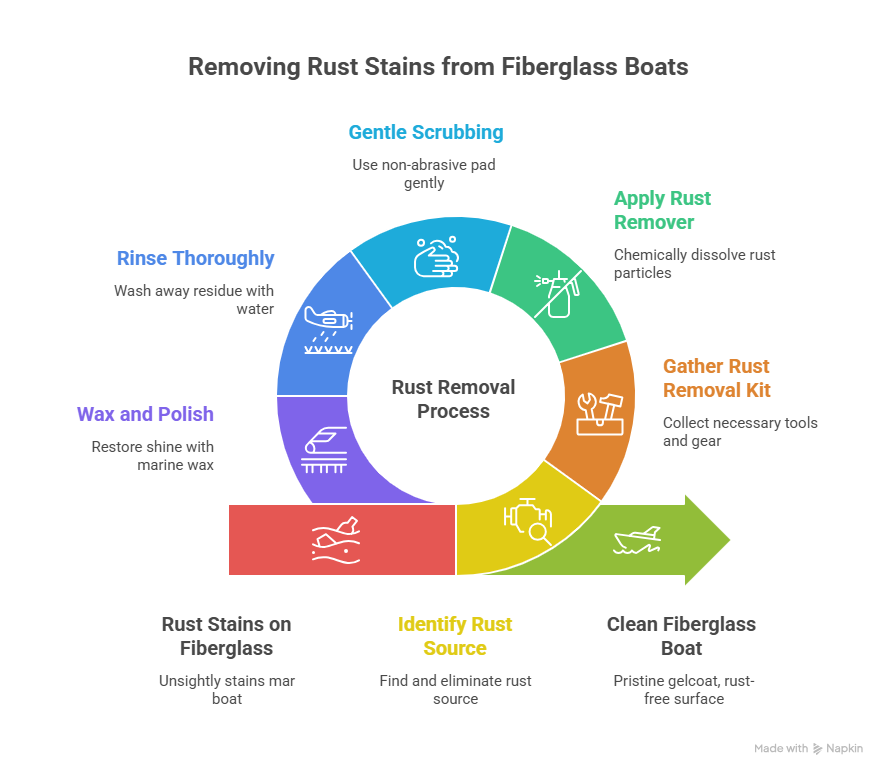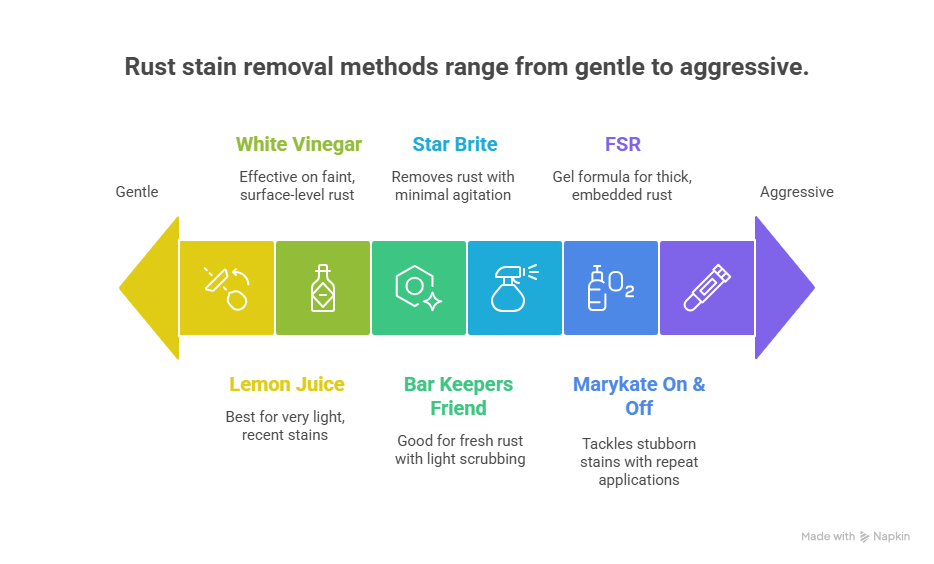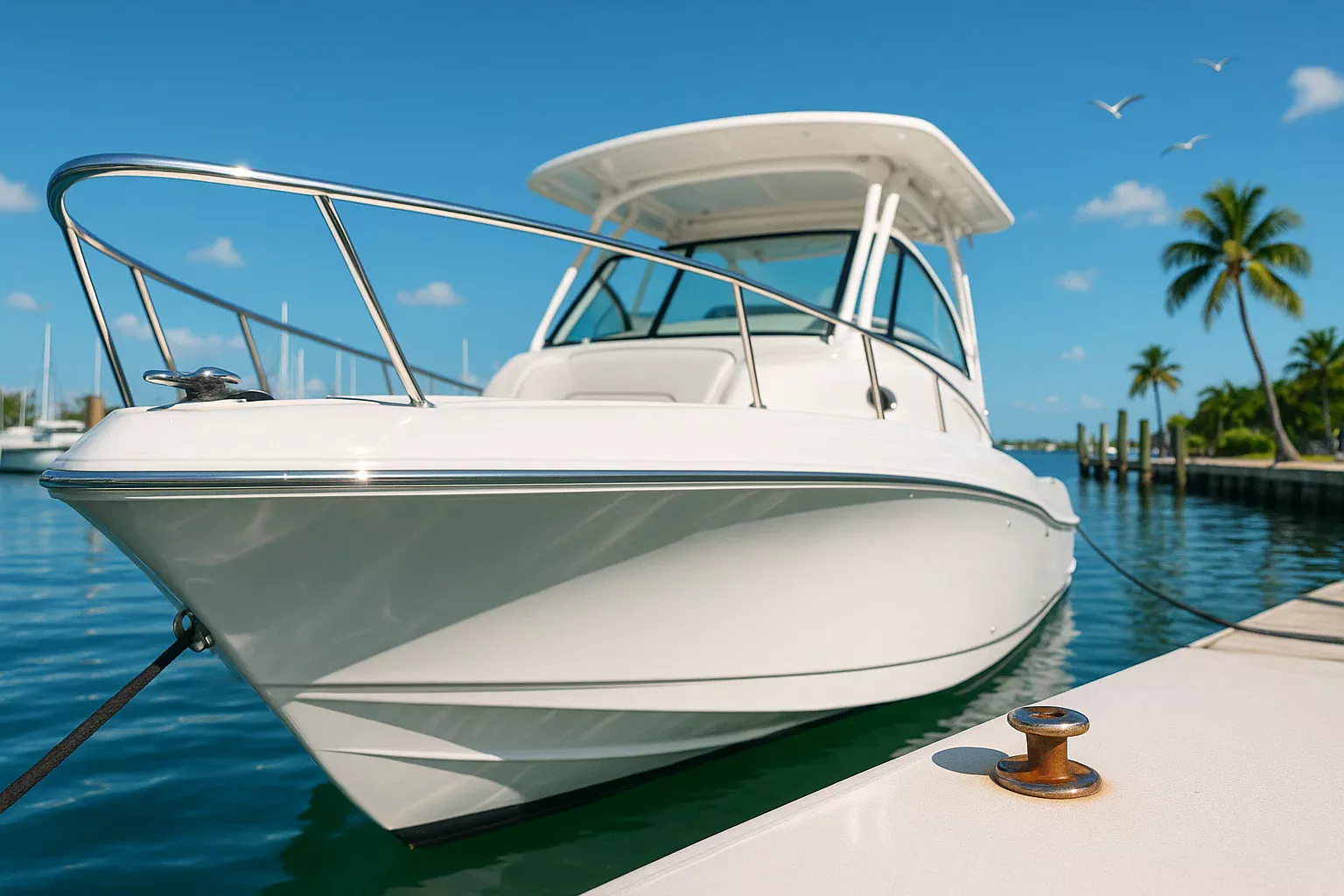I’ve been fixing boats in South Florida for 15 years, and nothing makes my blood boil like seeing a pristine fiberglass hull marred by ugly rust stains. Last June, a buddy named Carlos docked his Sea Ray 230 at Dinner Key Marina, cursing a reddish-brown streak on his gelcoat. “Tried everything,” he said. I grabbed my Star Brite Rust Stain Remover, sprayed it on, and in five minutes, the stain was gone—$30 well spent. Here’s my battle-tested process for removing rust from a fiberglass boat, protecting the gelcoat, and keeping those stains gone for good. Let’s dive in and get your boat looking showroom-new.
Table of Contents
Why Do Rust Stains Appear on Fiberglass Boats?
Fiberglass gelcoat looks sleek, but it’s got a dirty secret: it’s microscopically porous. Those tiny pores grab onto rust particles like a sponge. When iron from a rusty screw or dock runoff hits your hull and mixes with saltwater, it oxidizes into that reddish-brown mess. I’ve seen it a hundred times—boats at Bahia Mar picking up rust from a single boatyard grinding job nearby.
The real kicker? Rust doesn’t just sit there; it embeds itself. Scrubbing with soap won’t cut it. You need chemistry, not elbow grease, to lift it out without dulling your gelcoat’s shine.
What’s the Source of Rust on My Fiberglass Boat?
Finding the rust’s source is step one, or you’re just cleaning up a symptom. Last summer, a client at Key Biscayne had rust streaks on her Boston Whaler 210. Turned out, a 304-grade stainless cleat was weeping. I replaced it with 316-grade for $50—problem solved.
Common culprits include:
- Low-grade stainless fittings or screws losing their coating.
- Anchor chains or fishing tackle left on deck.
- Metal shavings from nearby boatyard work.
- Runoff from rusty dock fixtures.
Check every metal fitting on your boat. If you skip this, you’ll be back at square one in a month. A quick inspection saves you from endless cleaning.

What Tools Do I Need to Remove Rust from a Fiberglass Boat?
Before you start, gather the right gear. I learned this the hard way in 2012 when I scratched a client’s hull with a cheap scrub pad—$200 lesson. Here’s my toolkit for rust removal, built from years at Fort Lauderdale marinas.
- Marine Rust Remover: Star Brite or Marykate On & Off (oxalic acid-based) dissolves rust without eating gelcoat. Costs $20–$30.
- Application Tools: Spray bottle for liquids, soft sponge for pastes, and a white 3M non-abrasive pad for gentle scrubbing.
- Safety Gear: Nitrile gloves, safety glasses—acids are no joke.
- Rinsing and Finishing: Hose with fresh water, marine wax (like Meguiar’s), and microfiber towels.
I keep this kit in my truck. Makes rust jobs quick and keeps the gelcoat pristine.
Table: My Rust Removal Toolkit
I put this table together from jobs I’ve done in Miami:
| Tool/Item | Purpose | Cost | Where to Get It |
|---|---|---|---|
| Star Brite Rust Remover | Dissolves rust chemically | $25 | West Marine, Amazon |
| White 3M Scrub Pad | Gentle agitation without scratches | $5 | Hardware stores |
| Nitrile Gloves | Protects hands from chemicals | $10 | Any pharmacy |
| Meguiar’s Marine Wax | Seals gelcoat post-cleaning | $20 | Marine supply stores |
How Do I Safely Prepare to Remove Rust from My Boat?
Safety’s not just a buzzword—it’s what keeps your gelcoat and your skin intact. I once saw a guy at Stiltsville use a bathroom cleaner and dull his hull permanently. Don’t be that guy.
- Read the Label: Follow the rust remover’s instructions. Star Brite needs 2–5 minutes to work; don’t guess.
- Test First: Try the cleaner on a hidden spot (like under a hatch). I caught a bad batch of cleaner in 2023 that would’ve discolored a client’s deck.
- Ventilate: Work outdoors or in an open marina slip to avoid inhaling fumes.
- Protect Nearby Surfaces: Tape off painted stripes or electronics to avoid chemical runoff.
Prep right, and you’re halfway to a rust-free hull without new problems.
How Do I Remove Rust from a Fiberglass Boat with a Commercial Cleaner?
Here’s my go-to process, honed over 200 rust jobs. It’s simple, effective, and gelcoat-safe. Picture this: you spray the cleaner, watch the rust fade, and feel like a wizard.
- Clean the Area: Wash with boat soap and water to remove dirt or salt. Dry completely with a microfiber towel.
- Apply the Cleaner: Spray Star Brite Rust Stain Remover evenly over the stain. I used this on Carlos’s Sea Ray last June—covered a 6-inch streak in seconds.
- Let It Sit: Give it 2–5 minutes per the label. The oxalic acid dissolves rust chemically, so don’t rush it.
- Light Agitation: For stubborn spots, use a white 3M pad with gentle circular motions. I barely press—let the chemical do the work.
- Rinse Thoroughly: Flood with fresh water to remove all residue. I use a hose at 40 PSI to ensure no cleaner lingers.
- Check and Repeat: Dry and inspect. A second round usually clears any faint stains.
This method saved a client’s Grady-White 208 at Coconut Grove $500 in professional cleaning last year. It’s fast and keeps your gelcoat glossy.
Can I Use Household Products to Remove Rust from My Fiberglass Boat?
Sometimes you’re stuck without a marine cleaner. I was at a remote slip in the Keys in 2021, and a client’s Bayliner 245 had fresh rust spots. I grabbed Bar Keepers Friend from a nearby store—worked like a charm.
- Bar Keepers Friend: Mix the powder into a paste, apply with a sponge, let sit for 1–2 minutes, scrub lightly, and rinse. It’s oxalic acid, same as marine products.
- White Vinegar: For faint stains, soak a cloth, lay it on the spot for 15–30 minutes, scrub gently, and rinse. It’s weaker but safe.
- Lemon Juice: Similar to vinegar, good for tiny spots. I used it on a faint stain last month—took 20 minutes but worked.
Avoid toilet bowl cleaners like CLR. I saw a guy in Fort Lauderdale dull his gelcoat with one in 2022—$1,000 to repair. Stick to mild options and test first.
How Do I Handle Stubborn Rust Stains on My Fiberglass Boat?
For deep, old stains, you might need a second pass. Last July, a client’s Hatteras 54 at Bahia Mar had rust embedded from a rusty anchor chain. Two rounds of Marykate On & Off did the trick.
- Double Application: Reapply the marine cleaner, let it sit longer (up to 7 minutes if the label allows), and scrub lightly with a 3M pad.
- Stronger Products: If needed, use a gel-based remover like FSR for thicker coverage. I used this on the Hatteras—$35 and 10 minutes total.
- Professional Help: If the stain won’t budge, call a pro. A Miami detailer quoted $200 to buff out a deep stain I couldn’t shift in 2023.
Never use abrasive pads or strong acids like hydrochloric. They’ll etch your gelcoat, and you’ll be out thousands for a refinish.
Why Must I Wax My Fiberglass Boat After Rust Removal?
Rust removers strip wax, leaving gelcoat pores exposed. Skip this step, and rust comes back faster. I learned this in 2010 when a client’s cleaned hull re-stained in two weeks—$100 fix turned into $300.
- Choose a Wax: Meguiar’s Marine Wax for gloss, or 3M Marine Ultra for durability. Costs $20–$30.
- Apply It: Spread a thin layer with a foam pad, let it haze (5–10 minutes), and buff with a microfiber towel.
- Check Coverage: I run my finger over the area—should feel slick, not tacky.
Waxing seals the gelcoat, keeping rust out. It’s non-negotiable.

How Can I Prevent Rust Stains on My Fiberglass Boat?
Prevention beats cleaning every time. A guy named Javier at Stiltsville avoided $500 in repairs by catching a rusty screw early last spring.
- Inspect Hardware: Check fittings monthly. I replace any corroded bolts with 316-grade stainless—$2 each at West Marine.
- Rinse Regularly: Hose down with fresh water after every saltwater trip. Takes 10 minutes, saves thousands.
- Use Barriers: Nylon washers under fittings stop metal-to-gelcoat contact. I add these for $5 per job.
- Act Fast: Hit new stains immediately with vinegar or a marine cleaner. Early action prevents deep penetration.
I rinse my Boston Whaler weekly and wax every 6 months. Haven’t had a rust stain in years.
FAQ: Common Questions About Removing Rust from Fiberglass Boats
How often should I check for rust stains on my fiberglass boat?
Check monthly, especially after boatyard work or docking in new marinas. I caught a stain on a client’s Sea Ray in July 2024 from dock runoff—fixed it for $25. Use a flashlight to spot faint streaks early.
What’s the best product to remove rust from a fiberglass boat?
Star Brite Rust Stain Remover is my go-to. Its oxalic acid formula clears stains in 2–5 minutes without harming gelcoat. Costs $25 at West Marine and beats scrubbing.
Can I use CLR to remove rust from my fiberglass boat?
Avoid CLR—it’s too harsh. I saw a guy in Fort Lauderdale dull his hull with it in 2022, costing $1,000 to fix. Stick to marine cleaners or Bar Keepers Friend for safety.
How long does it take to remove rust from a fiberglass boat?
Most stains take 5–10 minutes with a marine cleaner. I cleared a 6-inch streak on a Grady-White in 7 minutes last month. Stubborn stains might need 15 minutes with two applications.
Why does rust keep coming back on my fiberglass boat?
You’re not fixing the source. A rusty cleat or dock runoff will re-stain fast. I replaced a client’s bolts for $50 in 2023, and his hull’s been clean since.
Do I need to wax my boat after removing rust?
Yes, or the stain returns faster. Rust removers strip wax, leaving gelcoat vulnerable. I waxed a client’s Bayliner after cleaning in 2021—still rust-free in 2024.
Can I prevent rust stains without professional help?
Absolutely. Rinse with fresh water weekly, inspect fittings, and wax every 6 months. I showed a buddy at Dinner Key how to do this—saved him $500 in repairs.
Conclusion
Rust stains on your fiberglass boat aren’t just ugly—they’re a threat to your hull’s value. But with the right approach, you can erase them and keep them gone. Last summer, I helped Carlos at Dinner Key restore his Sea Ray 230’s shine in under 10 minutes with a $25 cleaner. The trick? Find the source, use a marine-grade remover, and always re-wax. Inspect your boat this weekend, grab a product like Star Brite, and protect your gelcoat with a good wax. Your boat’s a reflection of you—keep it spotless and ready for the open water.
Author Bio
I’m Alex, a 15-year marine technician based in Miami, with ABYC certification and over 200 rust removal jobs under my belt. From Fort Lauderdale to the Keys, I’ve helped boaters keep their hulls pristine.


Leave a Reply